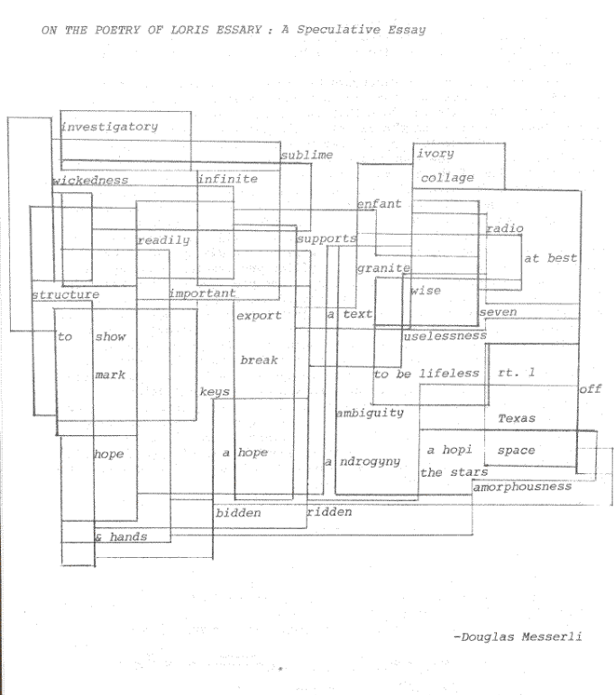The late 1970s and early 1980s saw North American poets Charles Bernstein and Bruce Andrews provide a space for L=A=N=G=U=A=G=E poets to publish their work, as editors of L=A=N=G=U=A=G=E Magazine.1 They published thirteen editions and three supplements between February 1978 and October 1981. An example of one of the poems published in Issue Three of L=A=N=G=U=A=G=E Magazine is Douglas Messerli’s ‘On The Poetry of Loris Essary: A Speculative Essay’.
 Douglas Messerli. ‘On the Poetry of Loris Essary: A Speculative Essay’. L=A=N=G=U=A=G=E Magazine, 3. 1978.
Douglas Messerli. ‘On the Poetry of Loris Essary: A Speculative Essay’. L=A=N=G=U=A=G=E Magazine, 3. 1978.
The poem is a visual mapping of the themes prevalent in Essary’s own poetry, presented visually as an homage to Essary’s poetry style. To make meaning of this poem, readers must look beyond the words themselves and consider the poem’s multimodal features: the poem’s layout on the page, the use of intersecting rectangles and how they interweave, the placement of words within those rectangles and how the words are broken up. The intertextuality with Essary’s suite of poetry is also key in understanding the poem. These multimodal features work together to present Messerli’s own interpretation of Essary’s poetry and in doing so, offers a commentary on the very act of analysing poetry itself. It also speaks to the paradox of L=A=N=G=U=A=G=E poetry, where in drawing the reader’s attention to the linguistic features at times further ostracises the reader from making sense of the poem. Here, the reader must look beyond the language and use the semiotic resources to make meaning.
A modern example of poetry that uses some of the techniques found within L=A=N=G=U=A=G=E poetry can be seen in Alison Whittaker’s 2018 poetry collection Blakwork, where she plays with language and form in her poems. Her poem ‘COTTON ON’ (p. 15) takes full advantage of the spaces between words and letters to add additional meaning and performative quality to the poem.2 It is a poem of only twelve words and three lines but takes up an entire page. The negative space between lines two and three represents the vast expanse of the ocean referenced in line two, allowing the reader to physically see and experience the distance: it takes effort to reach the poem’s final line. To overlook the linguistic and semiotic choices Whittaker makes in analysing this poem is to remove integral meanings that contribute to the reader’s overall understanding of the poem’s subject matter. By visually laying out the poem in this way, Whittaker creates a social context for the language she uses, offering more linguistic resources with which readers can make meaning of the poetry.
I use Whittaker’s poems as an example here not to suggest that Whittaker aligns herself with this movement; rather to illustrate that the techniques used by L=A=N=G=U=A=G=E poets during the period L=A=N=G=U=A=G=E Magazine was published are techniques that continue to be used by poets today. As Arnold writes, ‘If there is a point to discussing any aspect of what has come before, it is surely to create some kind of significance in the present.’3
Linguists are as fascinated by words and their meanings as they are by how we communicate without words. What is said in what’s left unsaid in the pauses and silences that stilt and puncture conversation? How does our body language betray the meanings of the words we speak, offering a subtext for the astute observer? What symbols do we use in place of words to communicate? Here, the craft of poetry further slips into linguistic play. Thuy On’s poetry collection Decadence is a delectable example of this merging of linguistic and poetic play. 4 ‘Murmuration’ (p. 34) plays with the shape of the word on the page to lay it out in the form of a murmuration of starlings. 5 On cuts the word down into phonemes, rebuilds the word, cuts it back down, then builds it back up, shaping the poem into a murmuration through the repetitions. Its visual composition enacts the word’s meaning and yet the reader need not read each individual iteration of the word in the poem to ‘read’ the poem. The poem can also be read visually, as an overall image of a murmuration. On paints a picture for the reader using only one word. It is not the word alone that gives this poem its meaning: it is On’s deconstruction of the word into phonemes and subsequent composition of those components on the page that work together to create meaning.
A criticism of the L=A=N=G=U=A=G=E movement is that at times the experimentation and language play undertaken by the poets can obfuscate meaning, shutting readers out instead of inviting them in. Yet a key change in our social context since the 1970s has been the shift from a textually literate society towards a more visually literate society. In our day to day lives, we rarely construct meaning in only one mode. Emojis slip into text messages and emails. Phone calls are frequently video calls. Social media includes a smorgasbord of modes for users to add to their posts: text, images, video, emojis, filters, sound. Whereas once communicating almost exclusively using spoken or written text was the norm, our modes of communication have shifted to become more visual spheres. Arguably, this suggests that poetry constructed using semiotics and the techniques of the L=A=N=G=U=A=G=E poets is more accessible. Not only for poets, with the advent of digital tools that help to construct poetry with more complicated layouts and shapes, but also for readers, who are more familiar interacting with texts that are multimodal and use semiotics than they are with texts that use only textual language.
- Charles Bernstein & Bruce Andrews (eds.). L=A=N=G=U=A=G=E Magazine. 1978-1981. ↩
- Alison Whittaker. Blackwork. Magabala Books. 2018. Broome. ↩
- David Arnold. Poetry and Language Writing. Liverpool University Press. 2007. Liverpool. p.2 ↩
- Thuy On. Decadence. UWA Publishing. 2022. Perth. ↩
- Ibid, p. 34. ↩













